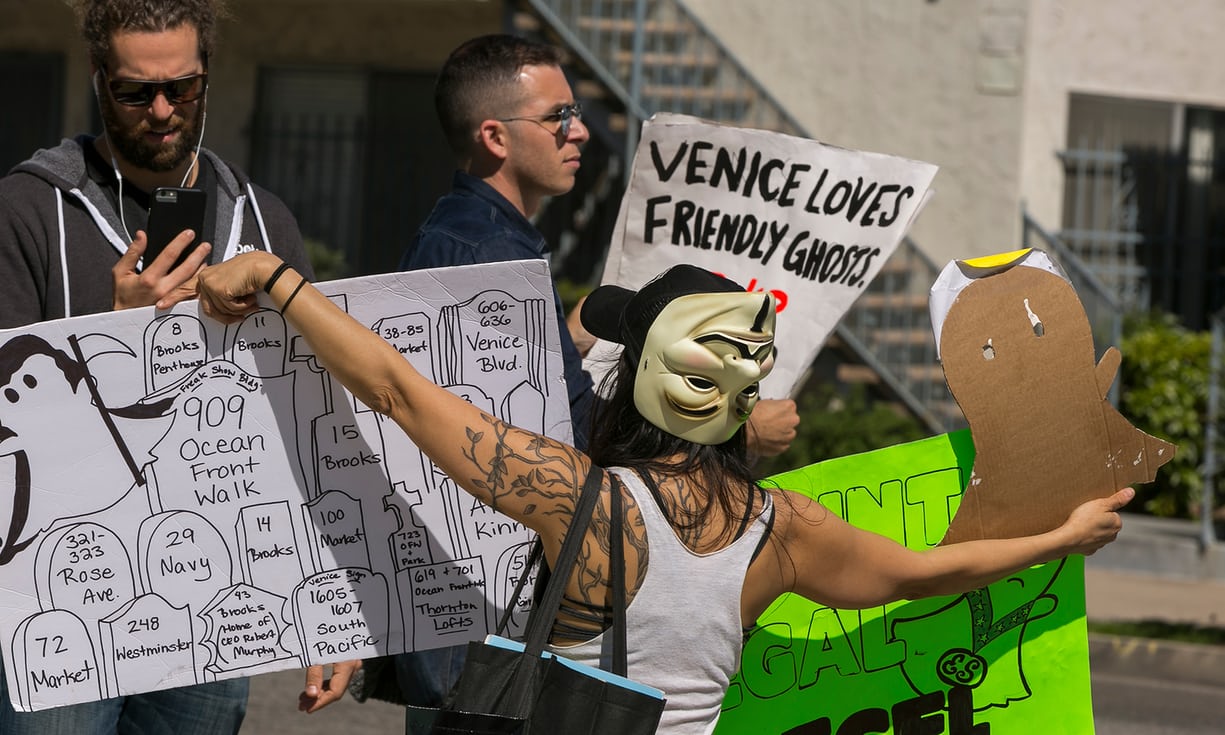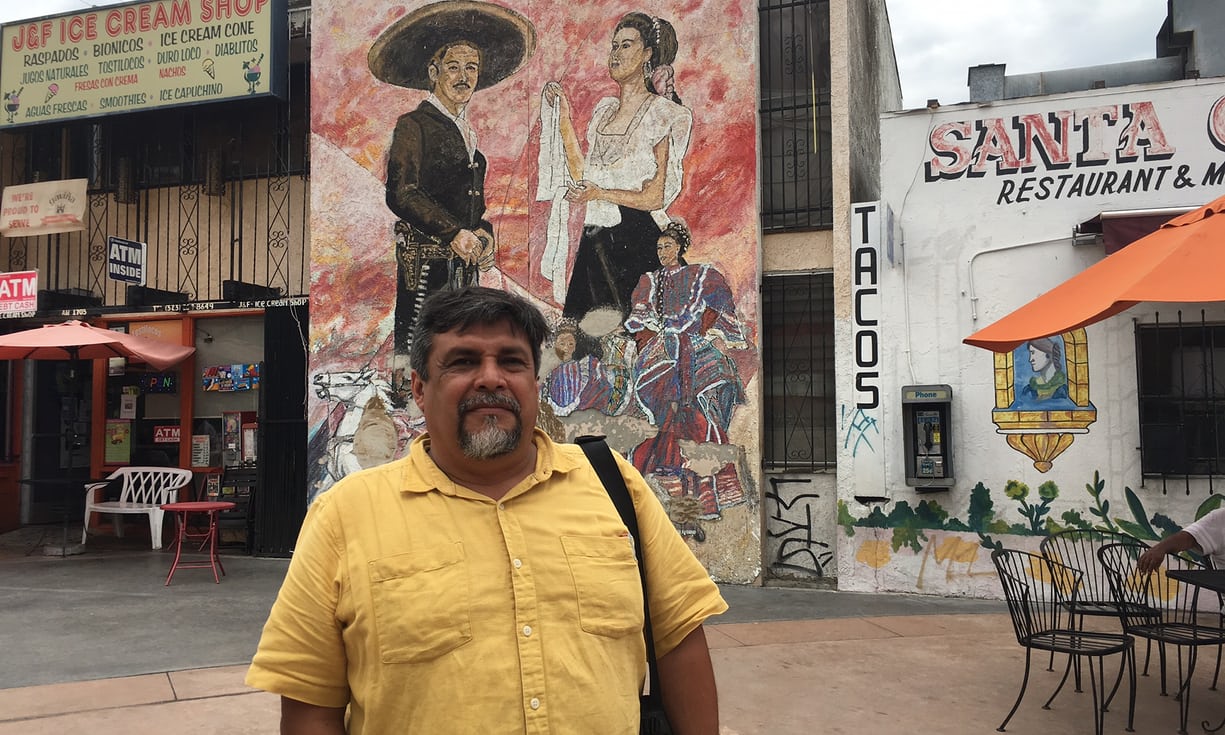Hipster-bashing in California: angry residents fight back against gentrification

In a state where house prices are twice the US average, artists and developers are feeling the ire of a growing movement to ‘defend our homes and our culture’

Protesters in Venice, California, have picketed the palm-fringed home of Snapchat. Photograph: Damian Dovarganes/AP
Friday, July 28, 2017
by Rory Carroll
Half a century after the summer of love and hippie harmony, California is experiencing a summer of loathing and hipster-bashing.
Not just hipsters. Artists, techies, realtors, business owners, developers, all are feeling the wrath of a burgeoning and in some cases radicalising anti-gentrification movement.
In the Los Angeles neighbourhood of Boyle Heights, protesters are targeting a new cafe with placards, chants and intimidation, tactics which ousted an opera and a gallery.
In Venice, on the other side of LA, residents picket the palm-fringed home of Snapchat, branding it a coloniser for taking over local real estate.
In San Francisco, activists blast Airbnb and bicycle-sharing initiatives amid nostalgia for a “yuppie eradication†project. And in Oakland non-profits stand guard against Uber’s plan to open a giant office downtown.
“We’re in a war,†said Leonardo Vilchis, a leader of Union de Vecinos, an LA-based activist group. “It’s happening across the state. A war to defend our homes and our culture.â€
Such rhetoric is quite a change from the flower-power vibe of 1967 when hippies took over San Francisco’s Golden Gate park and kick-started the counter-culture.
But the hippies, after all, just pitched tents. Today’s perceived interlopers rent, buy and flip property. And that’s a problem.
A housing crisis is making homes unaffordable for the poor and middle class, uprooting communities and condemning families to sleep in vehicles, shelters and under tarpaulin.
Gentrification – the process of affluent people moving into and transforming lower income neighbourhoods – was a term once confined to urban planning seminars. Now it has become a howl across California.
“People are waking up to the fact that the housing system is benefiting the real estate industry while more and more people suffer,†said Malcolm Torrejón Chu, of the Right to the City Alliance. “There is enormous anger and anxiety.â€
The median cost of a home in California is $500,000, twice the US national level. About a third of homeowners pay housing costs deemed unaffordable, according to a Harvard study. California also has the largest share of homeless residents who are unsheltered, at 66%, according to the department of housing and urban development.
The underlying cause is a housing shortage. Proliferating activist groups see gentrification as the front line, pitting them into an audacious attempt to redirect one of the world’s biggest economies – a $2.5tn engine of technology, real estate and tourism roaring at full throttle – to a different type of capitalism.
“The conditions are just getting worse so you’re seeing (the) emergence of new groups,†said Camilo Sol Zamora, housing, land and development campaign director for Causa Justa. “There needs to be a disruption. Not business as usual – diversity of tactics, being creative.â€
The movement is a mosaic: policy wonks and lobbyists; venerable non-profits with offices and donors; embryonic, rag-tag groups with cardboard signs; political radicals who dream of overthrowing capitalism; vigilantes with spray paint and rocks.
Some factions coordinate and collaborate, others keep their distance and do their own thing – a loosely interconnected, decentralised movement whose intellectual heroes range from Martin Luther King, Cesar Chavez and liberation theologians to Mao Zedong, Karl Marx and Antonio Gramsci.
Renters, artists, unions, LGBT communities and other groups are forming eclectic coalitions to try to swing public opinion behind ballot measures and legislative efforts to expand rent control and other protections.
“Folks are looking for creative and new ways to respond,†said Bruce Mirken, of the Greenlining Institute, a research and advocacy group. “Folks have found themselves needing to work together that haven’t necessarily before,†he said, citing the No Uber Oakland campaign. “A lot of us are still figuring out how all that works. Coalitions are invariably complicated.â€
The Homes for All campaign was mobilising assemblies across the US, said Torrejón Chu, of the Right to the City Alliance. Mass assemblies will gather in September to demand a halt to evictions and declare a renters’ state of emergency, he said. “It will be the largest event of its kind. We won’t win unless we coordinate.â€
Even so, activists admit the struggle is struggling. “When you’re dealing with really intense market forces it’s difficult,†said Mirken. “A lot of folks are trying to figure out what the hell can we do that will make a difference. You do see things happening that do make a real difference but bending the overall curve in a big way is really tough.â€
For some the solution is to become more radical, even destructive.
There is suspicion that arson attacks at construction sites in San Francisco’s east bay are linked to gentrification resistance. The most recent blaze – cause still unknown – burned so hot (1,160F) it was monitored by a National Weather Service satellite.
The targeted developers have vowed to rebuild on the ashes. Oakland council member Abel Guillen said fires would not help make housing more affordable. “It only speeds up displacement of existing residents,†he tweeted.
Vigilantes have struck outside California. In Philadelphia in May a 50-strong group linked to an anarchist group called Summer of Rage vandalised luxury cars and homes, ripped out security cameras and erected a banner saying “Gentrification is death. Revolt is lifeâ€. Two suspects were detained and charged.
The movement’s main laboratory for confrontational tactics is Boyle Heights, a gritty Latino neighbourhood on the fringe of LA’s booming downtown.
It has hosted sustained intimidation campaign against perceived potential gentrifiers, including an opera company which tried to perform in a local park, a student-led walking tour and a string of galleries. Some had exhibitions disrupted, others were tagged with graffiti such as “fuck white artâ€. One has left.
Weird Wave Coffee, a hipster cafe which opened earlier this month, is the latest target. Picketers, some with bandannas covering their faces, seek a boycott. Someone has smashed the windows twice in the past week.
“Direct action gets the goods,†said Ruben Ruiz, of Serve the People-LA (STPLA), a Maoist group. “The window smashing? It’s fantastic. I love it.†But he added: “We didn’t do it. We don’t do anything illegal.†He cited European and Turkish squatter networks as inspirations.
STPLA formed a coalition, Defend Boyle Heights, with other militant groups, including Union de Vecinos, a long-established local group. “We’re in a war against neoliberals, fascists and coconuts,†said Vilchis, a co-founder. The latter refers to Latinos deemed brown on the outside, white on the inside.
Non-profits beholden to political and corporate interests “negotiated their own defeat†and left neighbourhoods open to predation, a mistake Boyle Heights would not make, said Vilchis, 55, who grew up amid guerrilla campaigns in Acapulco, Mexico.
The campaign against Weird Wave may backfire. When the Guardian visited it had run out of coffee in part because so many people had come in to show solidarity. “We’ve been insanely busy,†said Jackson Defa, the co-owner.
Steven Almazan, former outreach chair of the Boyle Heights neighborhood council, said most residents were ambivalent about gentrification, recognising benefits as well as problems.
It is unclear if confrontational tactics can slow gentrification in Boyle Heights – rents are rising fast – but outside groups are watching and learning, said Elizabeth Blaney, a Union de Vecinos leader. “I think it is replicable. We’ve had groups from New York, Chicago and the bay area reach out to us.â€
Gay Shame, a San Francisco-based group, is a fan. “Many anti-displacement activists concede too soon, or dream too small, and we love Defend Boyle Heights because they are saying ‘get the fuck out’ and really that’s the only answer we should have,†a member said via email.
But Kevin Keating, an anarchist who used threats and vandalism as part of the Mission Yuppie Eradication Project in the dotcom era, poured cold water on the prospect of the San Francisco Bay area importing Boyle Heights radicalism.
The LA campaign blended race and ethnicity into what should be a strictly class struggle, he said. And Bay area activists lacked grit, he alleged, citing the fizzling of Google bus protests in 2015. “They folded like napkins. No staying power.â€
Others said that overlooked decades of grinding work and shifting public opinion. “The bus protests put tech’s responsibility on the map,†said Leslie Dreyer, an artist and activist leader. “For the first time folks from around the world were calling and asking about it.â€
Activists were succeeding in blocking some evictions, she said. “I’m hopeful that more tactics can bloom in the face of such dire times. The little victories keep me going.â€

